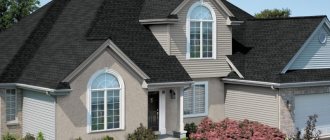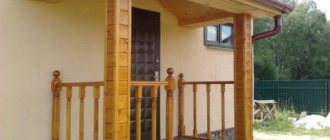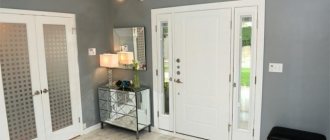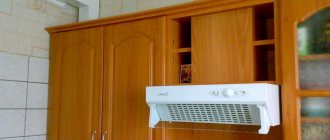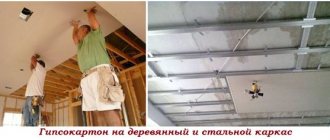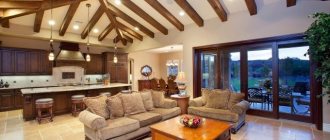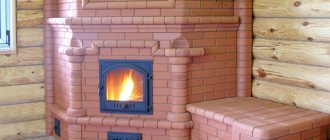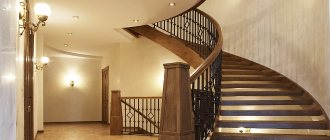Design features of modern ceilings
If the ceiling is beautiful, it means it is suspended and hidden behind it are wiring and other “charms” of the foundation. This is due to the fact that in our time the task is to obtain an aesthetic composition with minimal time, labor and money costs.
The most popular are slatted, glass and plasterboard suspended ceilings. All their types are united by the structure of the frame.
The latter must be made from environmentally friendly, fire- and moisture-resistant materials, be durable and withstand weight loads. Therefore, ceilings are most often constructed from aluminum and other metals, as well as PVC and treated wood.
Ceiling made of stretch PVC film
Another universal way to update the ceiling is to stretch a special vinyl film below its level.
The corresponding process is carried out as follows:
- First, a laser is used to mark the level of the future ceiling;
- Next, an installation profile molding is laid along the entire perimeter of the junction of the ceiling and the walls;
- The next step is the installation of plastic platforms for lamps;
- Then hangers are attached to the four corners of the baguette to hold the PVC film at a height;
- Next, the film is attached to the baguette around the entire perimeter and stretched.
Check it out here too!
Do-it-yourself countertop installation: selection, installation and fastening of the countertop. 155 photos of the best ideas and tips for their useDo-it-yourself canopy - beautiful ideas, best projects and tips on how to build a canopy with your own hands (90 photos and videos)
Do-it-yourself siding installation: stages of the work, step-by-step instructions for installing the siding and secrets of choosing high-quality siding (125 photos and videos)
Stretching is possible only when the temperature is heated to 60 degrees. To create the appropriate conditions, a heat gun is used.
For reference. When asking himself how to make a suspended ceiling with his own hands, the future installer often imagines a suspended ceiling.
In fact, the hanging option is carried out mainly by installing plasterboard sheets on a pre-designed frame.
However, the latter can also be finished with vinyl film. This has a certain advantage: the finished stretch ceiling hides communications and can withstand loads coming from above in the form of a flood.
How and with what to glue wallpaper?
It is important that the base surface is stable. Otherwise, it needs putty and primer.
The second point is the choice of glue. Each type of wallpaper has its own glue. Nothing complicated: all manufacturers indicate on the packaging what wallpaper this or that adhesive is intended for.
The glue is applied with a paint brush or roller. In the latter case, you will need a tray where you will need to drain the remaining glue by squeezing the roller.
- Combined bathroom - stylish design methods and examples of competent interior selection (125 photos)
How to install an interior door frame with your own hands - 130 photos and step-by-step installation video
- How to make a heated floor with your own hands - 160 photos and video description of how to make a heated floor
Of course, it is enough to apply glue to the ceiling foundation. However, in the case of glass wallpaper, vinyl and non-woven wallpaper, it is advisable to apply it also to the underside of the canvases. The air temperature in the room should be positive, without drafts.
Air bubbles under the wallpaper and excess glue must be carefully removed.
Useful tips
The procedure for arranging a finished ceiling in a private house differs little from the procedure for a city apartment (how to make a ceiling in an apartment?). However, it is additionally required to provide reliable hydro-, steam- and thermal insulation so that the heat from the rooms does not go to heating the attic space. The materials can be used exactly the same as for organizing similar effects in apartments.
If a private house is not used for permanent residence, but only for visits on holidays, weekends or during vacations, then materials of natural origin should be used as finishing. Then they will be less susceptible to damage due to inconsistent heat support in the premises.
Ceilings made from modern materials are also suitable for country houses and other types of private houses. Hinged, tensile structures provide an excellent view of the interior and perform the necessary functions:
- protection of floors from microclimate changes;
- changes in humidity and temperature;
- masking communications, electrical wiring;
- matches the style of the room.
Arrangement of the ceiling with your own hands involves creating a structure from different materials with the organization of heat, steam and waterproofing.
If in city apartments this is not required due to other residential areas located nearby, which act as this very barrier, then in the case of a neighborhood with a cold or warm attic or attic, additional insulation against heat loss is a necessary measure. Then you can save on heating costs and provide comfortable living conditions.
Features of finishing ceilings in cottages
Because Since most cottages have wooden floors, it is more difficult to plaster them without a special mesh.
However, these days, ceilings are not plastered, but decorated with tinted beams and wooden paneling treated with paint and varnish. It is already possible to install a suspended or suspended ceiling into this foundation.
Finish options
Depending on the type of construction, various options for finishing ceilings in a private house are used. The range of finishing materials is huge, and therefore the main methods should be analyzed. They are linked to the interior of the entire house, the organization of lighting, and the need for zoning the room.
Basic work
Most often, ceiling finishing is achieved by carefully leveling the surface and then applying a finishing coating that provides an attractive appearance and a certain design style. The most common methods are:
- Whitewash for plaster ceilings. First, the surface is leveled by puttying, priming and plastering. The process itself involves applying chalk or lime mortar. You can use a white background or tint with various pigments. The main advantages are the possibility of finishing it yourself, the low cost of the method and environmental friendliness. The ceiling is breathable. Lime whitewash has bactericidal properties. The disadvantages of whitewashing are the need to perfectly level the ceiling, fragility (the need to update the whitewash after 3-4 years), low moisture resistance, rapid contamination and problems with cleaning.
- Painting. This is the second most common method of finishing the ceiling. The most commonly used is water-based paint. It has all the main advantages of whitewashing, and at the same time has a certain moisture resistance. The painted ceiling can be wet cleaned using detergents. Other disadvantages of whitewashing are transferred to painting. In addition, the ceiling loses its “breathing effect”.
- Decorative plaster. The most popular is considered to be textured type plaster (it can be called structural, plaster, etc.). It contains a special filler with grains of various fractions. Using a textured solution, relief patterns are created. This finishing increases the decorative value of the ceiling and makes it possible to imitate stucco in a classic style. Disadvantages - increased cost and the impossibility of applying it yourself without special skills.
- Wallpaper. Pasting the ceiling is no different from covering the walls, except for the inconvenience of the location. Using wallpaper, you can provide its original colors (for example, imitation of natural materials). Wallpaper can mask small cracks, but in general it requires careful leveling of the surface. Washable materials can be easily cleaned with normal cleaning products.
- Tile. The ceiling can be covered with lightweight polystyrene foam tiles. Their main advantage is the provision of additional thermal insulation. The main disadvantage is flammability, with the release of harmful substances during fire. A rather expensive method, but without this drawback, is gluing glass or mirror tiles.
- Cork coverings. This applies to modern ways of arranging a room. This covering is made from sheets made from natural cork. It has a special attractiveness, increased water resistance and thermal insulation properties, but has a high cost.
- Liquid wallpaper. Essentially, this is a coating that combines the properties of wallpaper and plaster. It is made from a mixture based on cellulose fibers. The material is applied similarly to decorative plaster, and after hardening it takes the form of wallpaper. Liquid wallpaper creates a beautiful design, but is expensive.
- Stucco molding. It is most often made of plaster. Foam plastic figures are often used as imitation, which after painting are difficult to distinguish from real stucco.
We recommend: How to properly glue ceiling tiles? Types and choice of material
In general, finishing ceilings without additional load-bearing elements is most popular, provided there is a sufficiently flat ceiling surface. Its important advantage is its small impact on the height of the room.
Suspension systems
Suspended or frame ceilings are needed to mask large irregularities and create original multi-level structures with a special lighting system. The following arrangement options stand out:
- Panel ceilings. They are made of plastic panels that are mounted on an aluminum profile frame. The variety of textures makes it possible to design the ceiling in different styles. The panels are absolutely moisture resistant and have a reasonable cost.
- Sheet material. A ceiling with an almost perfectly flat surface can be equipped using sheet materials. The most commonly used is plasterboard (gypsum plasterboard). It is attached to a metal or wooden sheathing, and the seams are sealed with polyurethane foam or putty. After priming the surface, such a ceiling is ready for the finishing coat.
- Cassette ceilings. This is a special system in which rectangular cells for cassettes are formed using profiles and hangers. The most common sizes of such elements are 60x60 and 60x120 cm. They can be metal, polymer, glass, wood, mirror, or mineral materials. The main advantage is the absence of rigid fastening. The cassettes are easily removed, which makes it possible to wash or replace them.
- Slatted ceilings. They look quite beautiful and have practical value, especially for rooms with high humidity. Aluminum slatted plates are used. A silver or golden hue and chrome plating add a special decorative effect.
- Wooden coverings. Wood has always been popular in the design of private homes. The fashion has not passed even today. Such methods of finishing ceilings with wooden elements are noted.
- Lining. These wooden slatted panels have long gained wide popularity. They create a natural style and a special unity with nature indoors. To protect against moisture, it is recommended to impregnate the lining with an antiseptic and varnish it.
- Continuous covering - made of boards.
We recommend: Pros and cons of suspended ceilings in the bathroom. Selecting the type of installation feature
Suspended ceilings often become a necessary measure to hide construction defects. They require the installation of a supporting frame, which reduces the height of the room, however, decorative possibilities make it possible to compensate for this disadvantage.
Tensile structures
Stretch ceilings are designed to perform the functions of suspension systems in terms of masking irregularities, without creating additional loads on the ceiling. Their design includes a frame mounted on the wall and a canvas stretched under the ceiling at a distance of 10-12 cm from it.
There are 2 main types of them - fabric and film ceilings. In the first case, a textile fabric woven from polyester fibers is used. In the second case, PVC film is used. The canvas is fixed at its ends in the frame and stretched tightly, forming a flat surface. When stretching the PVC film, it is heated using a heat gun.
Plastic ceilings
If you are interested in how to decorate the ceiling with plastic panels with your own hands, a metal profile or wooden blocks are enough for the frame.
However, slatted ceilings include stringers and U-shaped strips, which can also be used to make a frame. For rooms where there is high humidity - just right.
How to raise the ceiling in an old house: what is needed for this
In order to raise the ceilings in your house, you need to either dismantle the structure and then create a new covering, or raise the frame by installing the lower cladding (suitable for small wooden houses).
You won’t be able to do this simply by hand—you’ll need to use additional equipment. The ideal option is to remove the roof, increase the walls to the required height and create a new ceiling level.
When it comes to a two-story house, such work will not be profitable - it is better to abandon the idea. That is, ceilings can only be raised from the attic side.
You need to remember that you will also have to:
- strengthen the base and foundation;
- level the cladding level of the main box and the added layer;
- prevent condensation at joints (sealed with basalt fiber).
Decorative plaster
To prevent the ceiling from looking too primitive, it needs to be given a spectacular and attractive look. Decorative plaster is used for this.
There is structural and textured plaster. The first type requires the addition of dyes and pigments - this plaster is only available in white. Textured plaster is produced in various colors in a ready-made form and is divided, in turn, into large-textured, medium-textured, fine-textured and fine-textured, depending on the diameter of 1 grain.
Based on the type of filler, they are divided into silicone, silicate, mineral and polymer. Mineral ones are suitable for all rooms, silicate ones are suitable for corridors and kitchens, because... protect the ceiling from dirt.
What should be the height of the ceilings in the house?
In almost every old house, the ceiling height slightly exceeds 2 meters. The modern standard is 2.4 meters. However, increasingly, the standard height is increasing to 3 meters. But you need to remember that in those houses that are located outside the city, too high a ceiling will create a whole lot of inconvenience. For example, it will be much more difficult to heat such a room with a stove. That is why the comfortable height is considered to be the same 2.4 meters.
In an unheated house, you can do even less. However, you will definitely need thermal insulation from the attic floor.
Based on all this, the optimal heights are:
- 2.1 meters - for houses that are heated by stoves;
- 2.4 - for gasified houses;
- 3 meters - if the ceiling is created in a monolithic structure (but they are still extremely rare).
Preparatory work
Before applying decorative plaster, it is necessary to level the surface using special plaster mixtures and perforated metal strips.
You can also make a 1-level ceiling by installing plasterboard sheets on the “base”, then apply plaster on them.
What ceilings to make in the house: options
Returning to the original question, we can answer that each case is individual, so it is impossible to say which ceilings are best for a particular house.
The strongest and most reliable are concrete ones, but they cannot be installed in an adobe or clay house (or even in a log or block house). Why? Because you need to take into account the maximum possible static load on the sheathing (ceiling support).
Restrictions are not introduced except when arranging the ceiling in concrete and brick houses, under which there is a monolithic foundation. That is, you should first consult with a specialist or engineer who will indicate whether the structure can withstand the increased weight.
When choosing a ceiling design, you only need to remember that:
- wood is not reliable and requires special care;
- adobe is not visually attractive, so it will have to be covered with finishing;
- concrete is the best option, but it won’t work to line the ceiling in a wooden house.
Even for brick ones it will not work with a strip foundation.
And, of course, every builder who undertakes the installation of a ceiling must also take into account his financial capabilities. Reviews say that using adobe is the most profitable business if it is not then covered with expensive finishing. If we cover it with finishing, then it will cost no less than a ceiling made of wood and concrete, and even more expensive, therefore, this option is more suitable for rich people.
How to apply decorative plaster
First you need to remove the old layer of plaster and dust the ceiling.
Then 1-2 layers of the primer mixture are applied with a break of 3-4 hours between application of layers.
The dry mixture is diluted in the proportion indicated on the package.
The DF is laid with a spatula: it is scooped onto it and applied to the ceiling, distributed evenly. It is also used to level and smooth the layer of plaster.
Next comes the actual decoration of the plaster layer. However, this need not be done if a composition with medium- or coarse-grained filler was used.
The techniques used depend only on your imagination.
A video of creating a ceiling with your own hands will serve as more visual instructions.
Ceiling insulation
There are a lot of options for what to use to insulate the ceiling with your own hands in a private home, and they all have their pros and cons.
- Mineral wool. This material is characterized by its resistance to fire and high thermal insulation. But over time, mineral wool loses its properties, and therefore begins to retain heat poorly, especially if a lot of moisture gets into it. Among the disadvantages, there is also the entry of small fibers into the upper respiratory tract, and accordingly their irritation. The cost of mineral wool is low - it is the most affordable insulation. When laying, you should be careful and avoid pressing it down, since the density of the material is extremely important for thermal insulation.
- Basalt wool. This type of insulation, such as basalt wool, is essentially one of the variations of mineral wool. But their difference is that this option holds its shape much better and caking is eliminated over time, which cannot be said about the mineral one. Just like mineral wool, it absorbs moisture.
- Expanded clay. Expanded clay is an excellent option for ensuring fire safety. Since it is a large-fraction insulation material, it is recommended to cover it with a layer of at least 15 cm, ideally 30 cm. Unlike other options, expanded clay is heavy. Therefore, it is not suitable for hemming to ceiling beams - due to its heavy weight, the fabric may break and entail various negative consequences. Expanded clay insulation is one of the inexpensive options.
- Styrofoam. Polystyrene foam is a flammable material. During combustion, it releases styrene, although there are environmentally friendly options. Foam plastic is ideal for thermal insulation - heat loss is eliminated, since no convection is created inside due to closed air cells. It does not lose its shape even over time and after decades it will be positioned in the same way as at the time of installation. Polystyrene foam is moisture resistant and impenetrable. The price of this type of insulation is high.
In more detail: “What is the best way to insulate the ceiling in a private house?”
For all materials intended for thermal insulation, waterproofing is provided, only when using foam plastic this is not necessary. To do this, you can use a special fabric or regular polyethylene with a high thickness. The strips overlap each other, and there should be an overlap (about 10 cm). All seams are tightly sealed with tape.
After the ceiling is insulated, the finishing process remains.
Photos of ceilings with your own hands
Tell your friends

